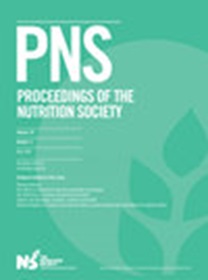植物提取的硝酸盐摄入量较低与身体虚弱的几率较高有关:对居住在社区的老年妇女进行的一项横断面研究
IF 7.6
2区 医学
Q1 NUTRITION & DIETETICS
引用次数: 0
摘要
衰弱是一种与衰老过程相关的独特健康状态,在衰老过程中,人体多个系统会逐渐丧失其内在储备,并与感官、神经、心血管和肌肉骨骼系统的衰退有关(1)。在此之前,已发现膳食中硝酸盐的高摄入量与虚弱的几个组成部分(包括肌肉力量和认知功能)以及血管疾病之间存在关系(2)。然而,人们对老年人膳食硝酸盐摄入量与虚弱之间的关系知之甚少。我们研究了从植物(如蔬菜、谷物、豆类和水果)和动物(如肉类、奶酪和酸奶)食品中摄入较多的习惯性硝酸盐是否与老年妇女的虚弱有关。珀斯老龄化妇女纵向研究(Perth Longitudinal Study of Ageing Women)的 1390 名社区老年妇女(平均年龄为 75.1 ± 2.7 岁)在基线(1998 年)时填写了一份有效的半定量食物频率问卷(FFQ)。食物中的硝酸盐浓度来自我们最近发布的国际动植物硝酸盐数据库,并应用于 FFQ 中的每种动植物食物(见3)。虚弱程度采用标准化的虚弱指数(FI)进行操作,该指数由多个健康领域(身体、精神、合并症)的 33 个变量的累积缺陷组成,得分≥0.25 表示虚弱。采用多变量调整逻辑回归模型作为限制性三次样条的一部分,分析了从植物和动物食品中分别提取的膳食硝酸盐与虚弱之间的横断面关联。模型对生活方式和饮食因素(FI 中未使用)进行了调整,这些因素包括年龄、吸烟史、蛋白质、酒精和能量摄入量。每日植物和动物硝酸盐的中位数(IQR)分别为 72.1(55.6-90.0)毫克/天和 3.5(2.2-5.1)毫克/天。在较高的植物硝酸盐摄入量与虚弱之间存在明显的非线性关系,当摄入量达到约 64 毫克/天时(四分位数 [Q]2 的中位数),摄入量达到最低点。具体而言,与植物源硝酸盐摄入量最低的妇女(Q1,中位数为 45 毫克/天)相比,Q2(OR 0.69 95%CI 0.56-0.84)、Q3(OR 0.67 95%CI 0.50-0.90)和 Q4(OR 0.66 95%CI 0.45-0.98)的妇女发生虚弱的几率较低(所有 p<0.05)。对饮食质量(每 1000 千焦富含营养素食物指数)或血浆 25- 羟维生素 D 总量的额外调整并未改变研究结果。研究发现,专门从蔬菜和谷物中提取的硝酸盐推动了这些结果的产生。在社区居住的老年妇女摄入较多主要来自植物的硝酸盐后,出现虚弱的可能性较低。每天摄入 1-2 份(75-150 克)富含硝酸盐的绿叶蔬菜,作为蔬菜总摄入量的一部分,将提供充足的硝酸盐水平(70 毫克/天),可作为限制虚弱的新型干预措施。本文章由计算机程序翻译,如有差异,请以英文原文为准。
Lower intake of plant-derived nitrate is associated with higher odds of frailty: a cross- sectional study in community-dwelling older women
Frailty is a distinctive health state related to the ageing process in which multiple body systems gradually lose their in-built reserves, and is associated with declines across sensory, neurological, cardiovascular, and musculoskeletal systems(1) . Previously, relationships have been identified between high dietary nitrate intake and several components of frailty including muscle strength and cognitive function, as well as vascular disease(2) . However, little is known about the relationship between dietary nitrate intake and frailty in older adults. We investigated if higher habitual nitrate intake, derived from plant (e.g., vegetables, grains, beans, and fruits) and animal foods (e.g., meats, cheese, yoghurt) was associated with frailty in older women.1390 community-dwelling older women (mean age 75.1 ± 2.7 years) from the Perth Longitudinal Study of Ageing Women completed a validated semi-quantitative food frequency questionnaire (FFQ) at baseline (1998). Nitrate concentrations in food were obtained from our recently published international plant and animal nitrate databases and applied to each of the plant and animal foods within the FFQ (described in3 ). Frailty was operationalised using a standardised frailty index (FI) of cumulative deficits from 33 variables across multiple health domains (physical, mental, comorbidities), with a score ≥0.25 indicating frailty. Cross-sectional associations between dietary nitrate derived from plant and animal foods (separately) with frailty were analysed using multivariable-adjusted logistic regression models as part of restricted cubic splines. Models were adjusted for lifestyle and dietary factors (not used in the FI) that included age, smoking history, protein, alcohol, and energy intake.Frailty was observed in 276 (19.9 %) women. Median (IQR) daily plant and animal nitrate were 72.1 (55.6-90.0) mg/day and 3.5 (2.2-5.1) mg/day, respectively. A significant non-linear relationship was observed between higher plant nitrate intake and frailty, with a nadir recorded once intakes of ~64 mg/day were achieved (median of quartile [Q]2). Specifically, compared to women with the lowest intake of plant-derived nitrate (Q1, median 45 mg/day), women in Q2 (OR 0.69 95%CI 0.56-0.84), Q3 (OR 0.67 95%CI 0.50-0.90) and Q4 (OR 0.66 95%CI 0.45-0.98) had lower odds for frailty (all p<0.05). Additional adjustment for diet quality (Nutrient Rich Food Index per 1000 kJ) or total plasma 25-hydroxyvitamin D did not alter the findings. Nitrate derived specifically from vegetables and grains were found to drive these results. No relationship was observed between animal-derived nitrate and frailty.Community-dwelling older women consuming higher amounts of nitrate derived primarily from plants were less likely to present with frailty. Consuming 1-2 servings (75-150 g) per day of nitrate- rich green leafy vegetables, as part of total vegetable intake, will provide adequate nitrate levels (>70 mg/day) that could serve as a novel intervention to limit frailty.
求助全文
通过发布文献求助,成功后即可免费获取论文全文。
去求助
来源期刊
CiteScore
15.50
自引率
0.00%
发文量
190
审稿时长
6-12 weeks
期刊介绍:
Proceedings of the Nutrition Society publishes papers and abstracts presented by members and invited speakers at the scientific meetings of The Nutrition Society. The journal provides an invaluable record of the scientific research currently being undertaken, contributing to ''the scientific study of nutrition and its application to the maintenance of human and animal health.'' The journal is of interest to academics, researchers and clinical practice workers in both human and animal nutrition and related fields.

 求助内容:
求助内容: 应助结果提醒方式:
应助结果提醒方式:


